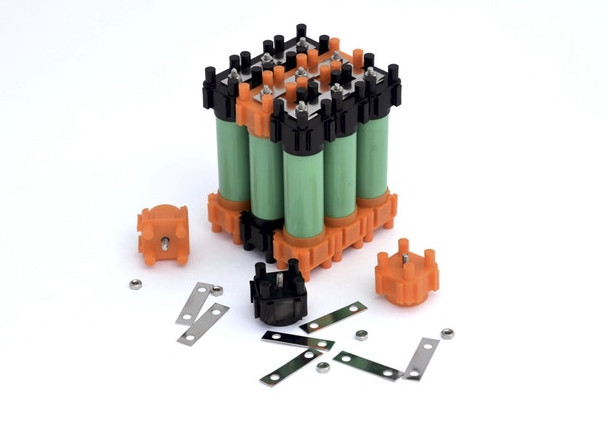If you have a project that requires some serious battery power, and can’t find a battery pack that matches your requirements, making your own is possible, but usually expensive as the commonly used spot welding method requires expensive tools.
Vruzend has created a modular lithium-ion battery building kit that greatly ease the making of DIY battery pack using 18650 battery cells using caps, nuts and bolts.
 There are two versions of the kit: V1.5 kit which supports up to 3.5A continuous and 7A peak per cell, and for higher power levels, the new V2.0 kit can handle up to 20A continuous (25A peak) per cell thanks to nickel plated copper-based conductors. It makes it suitable for EV racing, high power battery banks, and other power-hungry projects. The short video below explains how the kit works.
There are two versions of the kit: V1.5 kit which supports up to 3.5A continuous and 7A peak per cell, and for higher power levels, the new V2.0 kit can handle up to 20A continuous (25A peak) per cell thanks to nickel plated copper-based conductors. It makes it suitable for EV racing, high power battery banks, and other power-hungry projects. The short video below explains how the kit works.
https://www.kickstarter.com/projects/1354698863/diy-li-ion-battery-building-kit-make-your-own-1865?ref=nav_search&result=project&term=diy%20battery
Vruzend battery build kit is now offered on Kickstarter, and the projects has been fairly popular so far with $45,000 raised with 3 days to go. Rewards start at $25 for a single V1.5 kit good for up to 52 battery cells, and $28 for a single V2.0 kit for up to 30 cells. Other rewards combine multiple kits with up to 10 V2.0 kits for 300 cells ($260). Shipping adds $14 to $62 depending on reward, and delivery is planned for May/June 2018.
 If you are interested in the subject, but are not sure how to get started, the designer’s “DIY Lithium Batteries: How to Build Your Own Battery Packs” book should help.
If you are interested in the subject, but are not sure how to get started, the designer’s “DIY Lithium Batteries: How to Build Your Own Battery Packs” book should help.

Jean-Luc started CNX Software in 2010 as a part-time endeavor, before quitting his job as a software engineering manager, and starting to write daily news, and reviews full time later in 2011.
Support CNX Software! Donate via cryptocurrencies, become a Patron on Patreon, or purchase goods on Amazon or Aliexpress





Interesting, how do the ‘caps’ connect to the cells? If it’s some kind of spring terminal, then 20A seems unlikely. I just watched a video by ‘Great Scott’ on youtube about making a battery pack for his ebike conversion project and he used a small spot welder to make the contacts. That’s a more reliable method for higher currents–also less additional hardware.
Given they propose drone racing packs as one possible use of this, I would think minimizing both mass and vibration sensitivity would be important.
If these do use spring terminals, how are these better than some snap in battery holders like we’ve used for decades?
You can get a better look at the caps’ design in the video. It looks quite tight with the batteries. One of the benefits of the system is that you don’t need to buy a spot welder.
Their kits have already been used in e-bikes, solar powered vehicles, etc…
i forsee a bright future
perhaps they could integrate the thai plastic waterpipe equipment case design you posted not log ago